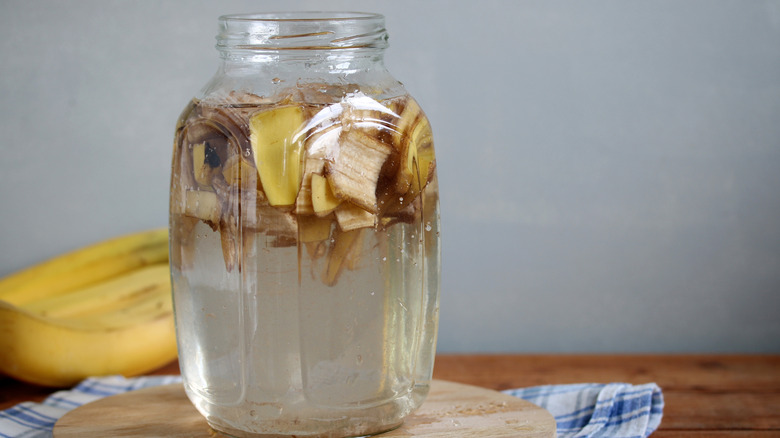The Simple DIY That Gives Your Old Potting Soil New Life
Nutrient-rich potting soil enables you to cultivate colorful flowers or home-grown vegetables. When the gardening season ends, though, you're left with containers full of tired-looking soil with questionable viability. Flowers and plant roots crave nutrients such as calcium, phosphorus, and potassium, which can be replenished with soil additives. One recipe for a "banana soup" additive was created by Donna Letier, Gardenuity CEO and co-founder, to enrich previously used soil and prep your soil for successful planting.
Of course, replenishing your potting soil will take some work. Couldn't you just dispose of the old soil at your local landfill, buy a few new bags, and call it done? Sure, but container gardening can be a pricey hobby. Those pots, potting soil, soil amendments, and natural pest control options aren't getting any cheaper. If you're on a budget, you're probably looking to cut expenses anywhere you can. Plus, if you're considering how to make your garden more sustainable, you likely want to minimize the debris that's dumped into your local landfill. Reconditioning your existing potting soil is a wallet-friendly move that accomplishes that goal. It's much more satisfying to contribute to the solution — not the problem.
How the banana soup solution works
Preparing the DIY banana soup is simple and fast. You'll need two bananas, three eggs, and 2 tablespoons of finely ground cinnamon. First, place a large pot onto your stove. Fill the pot with 3 to 4 cups of water and two banana peels. Boil the peels for 10 minutes. Next, add two to three crushed eggshells to the banana water. Blend in 2 tablespoons of the ground cinnamon. Cool the banana soup completely. Finally, pour the mixture over the used potting soil. For the next 24 hours, blend the soup into the soil to encourage even distribution.
This soil enricher has a few big advantages compared to a commercially available fertilizer. First, the lower nutrient dosage means you can apply the banana soup more frequently. Even better, diluting the mixture with fresh water means you can squeeze more applications from one batch — and that will save you some cash. Also, cinnamon is able to treat (and often prevent) minor plant fungal problems.
When to scrap DIY soil replenishment
If your recently expired plants were healthy and robust, the soil should be safe to use again with a replenishment of nutrients. However, consider the nature of the soil itself before determining if it's a good candidate for another round of plants. Let's say the compacted soil is so hard you'll need a jackhammer to plant anything. In this case, water (and banana soup) will have a tough time reaching the plant's roots. Poke holes throughout the compacted soil and break it up with a trowel or spiked tool, enabling those important liquid nutrients to flow as needed. Blending the banana soup into the soil will also help loosen it. Now, the potting soil is better prepared for another gardening season.
Also, don't reuse soil without first considering if it contains pathogens. Maybe the previous plants were infected by a fungus, bacterial growth, or other contaminant. Perhaps the soil stinks so bad it makes your eyes water. Even worse, hordes of hungry insects may have set up shop among your plants and potting soil. Some of them might still be there. If your previous container soil (or plants) fell victim to such calamities, reusing that soil could negatively impact the next batch of plants. If you suspect this might be the case, don't take the risk — just bag up the nasty mixture and head to the garden center for fresh new potting soil.


